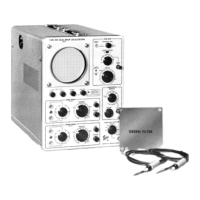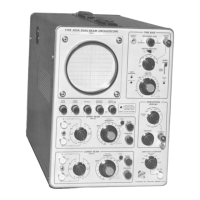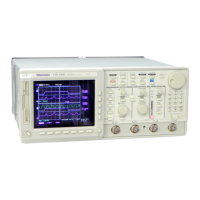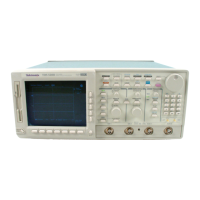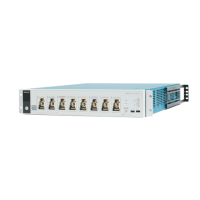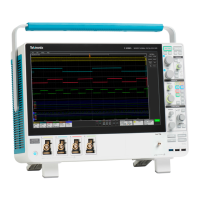Performance Check— Type 503
—
i
—
- J
t
Trace
seperation
easurement
, , . m
Fig. 5-1. Typical display, am plifier balance check (DC common
mode rejection ratio) — vertical amplifier; 1 mV/CM sensitivity.
f. Change the Standard Amplitude Calibrator output to
0.5 volts, and the HORIZONTAL SENSITIVITY switch to 1
mV/CM, and repeat step (d).
g. Check—The horizontal amplitude of the display should
not exceed 5 cm anywhere in the graticule area.
h. Change the HORIZONTAL SENSITIVITY switch to .5
VOLTS/CM, and the Standard Amplitude Calibrator to 50
volts, and repeat step (d).
i. Check—The horizontal amplitude of the display should
not exceed 2 cm anywhere in the graticule are, (50:1 CMRR).
j. Change the HORIZONTAL SENSITIVITY switch to 5
VOLTS/CM and the Calibrator output to 100 volts; repeat
step (d).
k. Check—The horizontal amplitude of the display should
not exceed 4 mm anywhere in the graticule area.
13. Check Compression or Expansion— Vertical
a. Requirement— Display amplitude change not more than
±1.5 mm with a 2-cm display.
b. Change the Standard Amplitude Calibrator output to
.5 volts.
c. Set the VERTICAL + INPUT switch to DC, and the
HORIZONTAL + and -INPU T to GND.
d. Move the Calibrator signal from the HORIZONTAL
+ INPUT connector to the VERTICAL +INPUT connector,
and set the VERTICAL SENSITIVITY switch to .2 VOLTS/CM.
e. The display should consist of two dots spaced verti
cally; center the display vertically and horizontally.
f. With the VERTICAL VARIABLE control, adjust the dot
spacing for 2 cm exactly, and move the display to the top
2 cm of the graticule.
g. Check— Dot spacing 2 cm ±1 .5 mm.
h. Move the display to the bottom 2 cm of the graticule.
i. Check— Dot spacing 2 cm ± 1.5 mm.
j. Return the VARIABLE control to CALIBRATED.
14. Check A m plifier Balance— Vertical (DC
Common M ode Rejection)
a. Requirement— Rejection ratios and deflection toler
ances as listed in Table 5-1, with specified input signals and
deflection sensitivities.
b. Set the VERTICAL —INPUT switch to DC, and move
the Calibrator signal from the HORIZONTAL —INPUT con
nector to the VERTICAL — INPUT connector.
c. Change the Standard Amplitude Calibrator to 5 volts.
d. Change the HORIZONTAL DISPLAY switch to SWEEP
NORMAL (X I). The INTENSITY may have to be increased
to view the display.
e. With the VERTICAL POSITION control, move the dis
play to the top line of the graticule, and then to the bottom
line of the graticule.
f. Check— Deflections as indicated in Table 5-1. See
Fig. 5-1 for a typical display.
TABLE
5-1
Input Deflection
Rejection
'Maximum
Deflection
(trace
Signal
Sensitivity Ratio separation)
5 volts .2 VOLTS/CM 100:1
2.5 mm
0.5 volts
1 mV/CM
100:1
5 cm
50 volts .5 VOLTS/CM 1
50:1 2 cm
100 volts 5 VOLTS/CM |
50:1
4 mm
'The degree of
trace separation should be checked by positioning
the display over the entire graticule area.
15. Check Attenuator Accuracy— Vertical
+ Input and — Input
a. Requirement— Vertical deflection accuracy within ±3 % .
b. Set the VERTICAL -INP UT switch to GND.
c. Change the Standard Amplitude Calibrator output to
5 mV, and change the VERTICAL SENSITIVITY switch to 1
mV/CM.
d. Check— Vertical deflection of 5 cm ±1 .5 mm.
e. Set the Standard Amplitude Calibrator output and
VERTICAL SENSITIVITY switch as indicated in Table 5-2,
checking for the deflections listed.
f. Change the VERTICAL +INPUT switch to GND, and
change the VERTICAL —INPUT switch to DC.
g. Repeat step (e).
16. Check Attenuator Accuracy— Horizontal
+ Input and — Input
a. Requirement— Horizontal deflection accuracy within
±3% .
b. Move the two 50-ohm cables from the VERTICAL + IN
PUT and -INPUT connectors to the HORIZONTAL -f INPUT
and -INPU T connectors.
5-4
©
